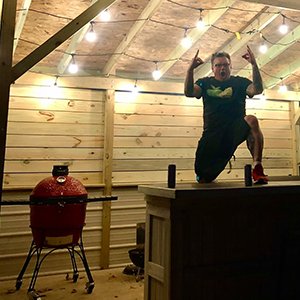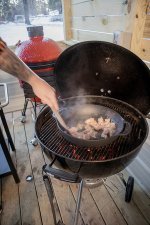How to cook meat safely
Knowing how to cook meat safely (and how to store it before and after cooking) can prevent you from getting sick and prevent your underdone food from going to waste!
Getting "up to temp"
When grilling meat, I am very diligent about making sure that I cook it to the recommended temperature. Meat can harbor bacteria (like E. coli and salmonella), and the last thing I want to have happen is for my family — or a friend who attended my backyard get-together — to get sick.
Bacteria are killed at 160 degrees Fahrenheit (71 degrees Celsius), so it is imperative to get the external temperature of meat to 160 degrees Fahrenheit or higher. Generally if the exterior of the meat is “browned,” it is above 160 degrees Fahrenheit.
With the exception of poultry, it is o.k. to eat whole muscle meat that has an interior temperature below 160 degrees Fahrenheit because the bacteria only lives on the outside of the meat (assuming the meat has been handled properly). For poultry, the internal temperature should be 165 degrees Fahrenheit.
Once meat has been ground up, the external temperature rule does not apply. Ground meat needs to be grilled to 160 degrees Fahrenheit internal temperature since it is not an intact piece of meat.
Fish typically should be grilled to 145 degrees Fahrenheit. At this temperature, the fish should flake easily with a fork. For shrimp, lobster, scallops and crab, you can determine a safe temperature when the skin is white and opaque. Clams, mussels and oysters should be grilled until their shells open.
Recommended internal meat temperatures:
(all temperatures are in Fahrenheit)
Poultry
165 degrees
Fish
145 degrees
Beef and lamb
Rare: 125 degrees
Medium rare: 135 degrees
Medium: 145 degrees
Medium well: 150 degrees
Well done: 160 degrees
Ground: 160 degrees
Pork
Medium: 145 degrees
Medium well: 150 degrees
Well done: 160 degrees
Ground: 160 degrees
I definitely recommend using a meat thermometer to check for the safe temperature of your grilled meats. I really like the Thermo Pro instant read thermometer. When using a meat thermometer, always make sure you stick it into the thickest part of the meat but not touching a bone. The bone is typically cooler than the surrounding meat, so that could affect the accuracy of your reading.
Safe handling prior to cooking
Reprinted from healthline.com
Wash your hands frequently when preparing any type of meat, fish, or poultry. Bacteria can quickly spread between your hands and meat. Always wash your hands with soap and water for at least 20 seconds before and after handling meat, whether it’s raw or cooked.
Because bacteria can spread easily, prepare the meat on a surface that’s separate from all other cooking materials. Keep vegetables and other ingredients away from meat, especially if you aren’t cooking them together in the same dish.
Try to use separate cutting boards, clean all cooking utensils after they touch raw meat, and use different utensils to serve food after you’ve prepared it.
Safe handling after cooking
Reprinted from USDA
Discard any food left out at room temperature for more than 2 hours (1 hour if the temperature was above 90 °F).
Place food into shallow containers and immediately put in the refrigerator or freezer for rapid cooling.
Use most cooked leftovers within 3 to 4 days.
Reheat leftovers to 165 °F.
Recommended internal meat temperatures:
(all temperatures are in Fahrenheit)
Poultry
165 degrees
Fish
145 degrees
Beef and lamb
Rare: 125 degrees
Medium rare: 135 degrees
Medium: 145 degrees
Medium well: 150 degrees
Well done: 160 degrees
Ground: 160 degrees
Pork
Medium: 145 degrees
Medium well: 150 degrees
Well done: 160 degrees
Ground: 160 degrees
- Home
- How-To Grilling Basics
- How to Cook Meat Safely


